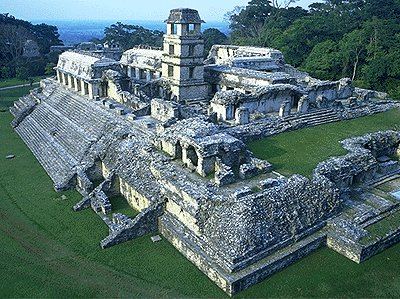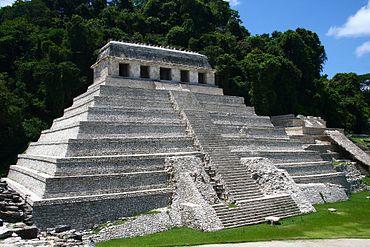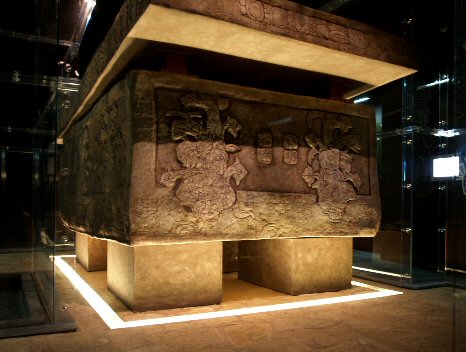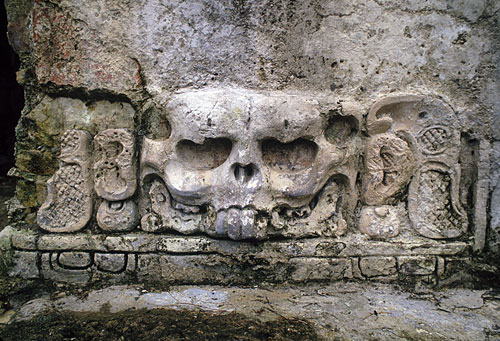|
Location:
Nr Usumacinta River, Chiapas,
Mexico. |
Grid Reference: 17�
19' 2.4" N. 92� 2' 20" W |
  Palenque:
(Mayan Pyramid Complex).
Palenque:
(Mayan Pyramid Complex).
Palenque is a relatively small Mayan
complex, much smaller than such huge sites as Tikal or Copan, but it
contains some of the finest architecture, sculpture, and bas relief carvings
ever produced by the Maya.
The tomb of Pakal is one of the Gems
in the Pre-Columbian crown
The complex spread out from the top of an artificially
levelled hill. Archaeologists estimate that only 5% of
the total city has been uncovered.
(Click here for map of the site)
An ancient name
for the central core of the city was Lakam Ha, which translates as
"Big Water", for the numerous springs and wide cascades that are found
within the site. Palenque was the capital of the important Classic period
Maya city-state of B'aakal or B'aak (Bone).
Spence
(1), says: ' The entire city of Palenque was
solely a priestly centre, a place of pilgrimage'. The city is laid out in
the shape of an amphitheatre, with a central pyramid.
The earliest contemporaneously dated monument at Tikal
is from the ' Tikal
Stela 29', which gives a date of 292 AD (8.12.14.8.15)
(3)
|
 The 'Palace' The 'Palace'
A single storey building built in the shape of an
irregular quadrilateral (unusual for Mayan constructions), and inside
which three subterraneous 'apartments' can be found down a 180ft deep
'flight of gloomy steps'. Here are found one of the many mysteries of
Palenque, in the shape of three great stone tables (alters), 'fretted
with sculptured symbols'
(1).
Originally this tower did not have a roof. Early
archaeologists reconstructing the site, ignorant of the Mayans
sophisticated astronomical knowledge, did not understand the purpose of
a roofless platform (for viewing the stars) and thus capped it with a
roof of their own design. |
|
The Temple of Inscriptions: (The Tomb of Pakal).

The Largest Stepped-pyramid at
Palenque and resting place of Lord Pakal.
The Temple of Inscriptions was
begun perhaps as early as 675AD as the funerary monument of
K'inich Janaab' Pakal. The Temple of Inscriptions records
approximately 180 years of the city's history from the 4th through
12th K'atuh. It houses the second longest glyphic text known from
the Maya world (the longest is the Hieroglyphic Stairway at
Copan).
The Pyramid measure 60 meters
wide 42.5 meters deep 27.2 meters high The Summit temple measure
25.5 meters wide 10.5 meters deep 11.4 meters high. The largest
stones weigh 12 to 15 tons. These were on top of the Pyramid.
The Total volume of pyramid and temple is 32,500 cu. meters.
(2)
In 1949,
Mexican archaeologist Alberto Ruiz Lhullier removed a stone slab
in the floor of the back room of the temple superstructure
revealing a staircase (Filled in shortly before the city
was abandoned), which plunged into the heart of the pyramid.
After three years of excavating, he reached the burial chamber
in 1953. It contained a 20-ton stone coffin with a wonderfully
carved lid. Inside was the skeleton of the Mayan ruler Pakal (Pacal),
heaped with jade.

The tomb is remarkable for its large
carved sarcophagus, the rich ornaments accompanying Pakal, and for
the stucco sculpture decorating the walls of the tomb. Unique to
Pakal's tomb is the 'psychoduct', which leads from the tomb
itself, up the stairway and through a hole in the stone covering
the entrance to the burial. This psychoduct is perhaps a
physical reference to concepts about the departure of the soul at
the time of death in Maya eschatology where in the inscriptions
the phrase ochb'ihaj sak ik'il (the white breath
road-entered) is used to refer to the leaving of the soul.
(More
about Holed-Stones)

The much-discussed iconography of the sarcophagus lid is commonly
believed to depict Pakal in the guise of one of the manifestations
of the Maize God emerging from the underworld with the 'Tree of
Life' motif in the background.

In no other part of America has a tomb
like this been found. The crypt is on display at the Museum of Palenque.
|
|
Temple of the Skull's

The sole surviving portion of the stucco decoration
on the Temple of the Skull (Temple XII) at Palenque is the skull above.
Visitors to the ruins might notice it just as they enter the ruins,
looking up at the temple�s one remaining pier. The skull was clearly
part of a larger composition, and its position at the base suggests it
served as a pedestal for a standing figure, much like the skeletal heads
beneath the feet of the royal portraits on piers of the Temple of the
Inscriptions.
|
Temples of the Cross group.
The
Temple of the Cross, Temple of the Sun, and Temple of the Foliated
Cross. This is a set of graceful temples atop step pyramids, each with
an elaborately carved relief in the inner chamber depicting two figures
presenting ritual objects and effigies to a central icon. The
cross-like images in two of the reliefs actually depict the tree of
creation at the centre of the world in Maya mythology.

It is said that if
three people stand on top of the three main pyramids, a three-way
conversation can easily be held without shouting.
(More about Sonics in
Ancient Structures)
|
Other structures include:
The Aqueduct
constructed with great stone blocks
with a three-meter-high vault to make the Otulum River flow
underneath the floor of Palenque's main plaza.
The Temple of The Lion
at a distance of some 200 meters
south of the main group of temples; its name came from the elaborate
bas-relief carving of a king seated on a throne in the form of a
jaguar.
Structure XII
with a bas-relief carving of the God
of Death.
|
Archaeoastronomy at Palenque:
The four-story tower,
the only one of its kind in Mayan architecture, is suggested as having
been an astrological observatory. During the winter solstice on December
21, the setting sun lines up from the Palace tower to the centre of the
Temple of the Inscriptions, where Pakal is buried.
(More
about Archaeoastronomy) |
(Other
Mexican sites)
(Index of Ancient Sites) |






